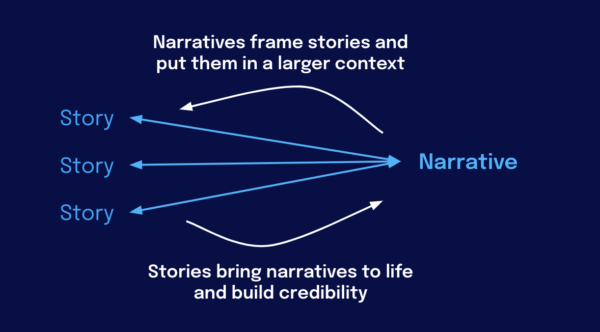What it takes to move from tactical to strategic storytelling
Because narratives are more powerful than stories.

Frank Wolf is co-founder and chief strategy officer at Staffbase.
If you want people to remember a piece of information, wrapping it in a story is one of the most powerful tools at your disposal. Studies show we recall stories anywhere from seven to 22 times better than isolated facts. Though, of course, the quality of the story matters.
Which would stick with you more—hearing that persistence leads to success, or hearing the story of Thomas Edison, who famously failed 1,000 times before inventing the lightbulb?
But the real magic of storytelling isn’t just in helping us remember. The true power lies in how stories guide us through a transition—moving us from an old world into a new one, helping us grasp complex ideas, and feel the weight of transformation. That’s what makes storytelling not just memorable, but transformative.
Senior leaders often think about the future regarding business strategies and goals. That’s the end state. But we all know the real challenge lies in the change and transformation needed to move from the current state to the desired future state. This is where we enter the sweet spot of communications. Like storytelling, it’s about understanding where your audience is today—their beliefs, dreams, and identities—and what story needs to be told to shift the narrative toward the desired future.
The communicator’s storytelling structure
Telling engaging stories might be the ultimate goal for the entertainment industry but the same isn’t necessarily true for communicators.
However, whenever we talk about storytelling, attention often turns to professional storytellers from the entertainment industry. If you work for Disney and attend a communications conference to lead a session on storytelling, you can be sure it will be overcrowded.
This focus on structure is why there’s such an emphasis on the classic hero’s journey: the hero discovers a problem, meets a guide, and eventually overcomes their challenges.
But the entertainment industry aims to engage audiences and get them to subscribe to Netflix or sign up for a paid newspaper. Corporate communication, on the other hand, isn’t about entertainment—it’s about changing hearts and minds.
Changing hearts and minds is hard in a world full of noise. Telling a single story isn’t enough. Our attention spans have become so short that cutting through the noise has become increasingly difficult.
We need to hear information multiple times to take action.
Not only do stories help us remember, but they also guide us through change. One or two stories might be enough to be noticed, but it takes more to make people remember what you want them to. It takes even further repetition to build trust in your message and even more for people to take action.
Many studies support these insights. For instance, a study by Robert B. Zajonc and others from 1968 describes the Mere Exposure Effect, where people start to like things after being exposed to them about five times. In marketing, there is a widely accepted “Rule of Seven,” which suggests that people need to hear something seven times before they are likely to take action.
That’s why storytelling should not be viewed as merely a tactical technique for packaging information. Yet, we often see communications teams thinking of themselves as service centers, helping leaders and subject matter experts wrap their knowledge in better stories. As one of our clients once said, “In an average year, our communications team tells more than a thousand stories, but we don’t create impact. Our main goal is to focus on fewer topics and ensure these tell diverse stories that all feed into the same overarching narrative.”
This is where strategic storytelling comes into play. It’s about aligning multiple stories behind a joint strategic narrative. Strategic storytelling allows communications teams to focus on initiatives that create business impact and drive key transformations.
Narratives are more powerful than stories
People often use “story” and “narrative” interchangeably, but storytelling and narrative are different concepts. Narratives are patterns that emerge from multiple stories.
Stories and narratives share common elements. The most important is their basic structure — they have a beginning, then something happens, and then there is a new end state. This structure is immensely helpful if you want people to follow a vision. It’s not just about where you want to go (the end state), it’s also about the journey of getting there.
No matter how powerful stories are, they are mostly about other people’s experiences. Narratives, however, invite us to become participants. This inclusivity is what makes narratives so powerful — they turn abstract ideas into personal motivations, allowing people to see themselves in the larger scope and be part of a movement or cause. For example, a specific founding story of a company becomes powerful when people can relate to it based on their own experiences or stories they’ve heard from others.
Consider Patagonia, which has successfully built a narrative around environmental activism. Their stories of sustainable business practices feed into the larger narrative of a company committed to saving the planet.
This is why any impactful communications strategy should focus on the narratives you want to create or change through your storytelling. For example, a topic like “Let’s do more about sustainability” is a topic, not a narrative. A sustainability narrative would be “We are transforming this business to be carbon neutral by 2040.”
A clear and powerful narrative will allow a communications team to identify and elevate the best facts and stories to build and nurture the narrative. The broader scope of a narrative also helps in connecting with current events and opportunities through approaches like agenda surfing or newsjacking.
What narrative are you crafting for your organization?
How to get started
The main insight is to completely reverse the way of thinking. In many cases, communications functions as a service center, engaging with all stakeholders to learn about the stories that need to be told. This bouquet of stories is often hastily squeezed into something resembling a strategy, but not necessarily a coherent one.
The strategic storytelling approach starts with the reputation you want to build and protect. You then identify the corresponding narratives that need to be shaped. After that, it’s time to find the right stories to support these narratives.
The result is a communications team that says “no” much more often than stakeholders would like to hear. However, the reward is fewer, but far more impactful campaigns, along with measurable impacts on the most important transformation and reputation drivers in the business.
By focusing on strategic narratives, you’re not just telling stories — you’re shaping the future of your organization.
Wolf goes deeper into strategic storytelling on free Staffbase’s free webinar, “What Taylor Swift Can Teach You About Elevating Your Comms Strategy,” Nov. 12 during Ragan’s Communications Week. Register here.










